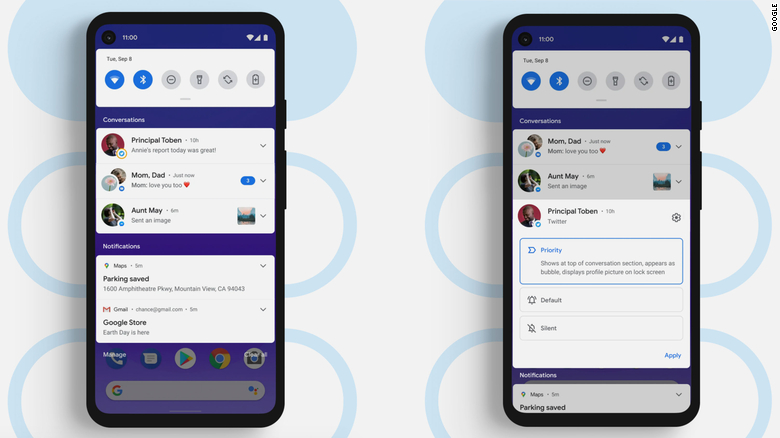Lrn&Shr
Latest News / Articles
Android and iPhone are similar phones but some things made different them from each other. Apple is only company which makes iPhone. That is why Apple has full control over its hardware and software. Due to this reason the hardware or software are very good of iPhone. On the other hand, there are so many companies which make android phones. Every company has its own specialty.Google offered the android software in many phones. Android phones are also good in size, weight, features and quality.(Source-mobileslatest.com)

Managing notifications in Android 11 is a lot easier. Source: CNN
It's hard to find a better smartphone than the iPhone. It's beautiful, it's fast, it's easy to use and as Steve Jobs would say, "It just works." But Android is no slouch, and it gets one crucial feature so right -- and it's a feature that Apple keeps screwing up.
Android is just better at notifications.
Currently, Google (GOOGL) widened the gap between Android and iOS when it introduced Android 11. The new smartphone operating system makes the most annoying, intrusive thing about your phone easier to manage.
Notifications in Android 11 are now grouped in three categories: conversations, notifications and silent. By separating conversations -- WhatsApp, Messenger, texts, DMs, etc. -- from the rest, it puts the most important stuff front and center.
Android 10 kinda, sorta achieved this by reordering your messages. When you pull down from the top of your screen in Android 10, instead of seeing your notifications in the order you received them, you see them in the order Google's artificial intelligence thinks you'll want to see them. That's often -- but not always -- texts and conversations on top. By separating conversations, however, Android takes a lot of the AI guesswork out, making notification navigation easier.
But that's not the best part of Android 11's notification update. Google also created a new way to interact with your friends and family, so you no longer have to hunt and peck around to get back to the conversation you were just having when your buddy texts you back. Chat bubbles are Android's new method of making conversations more fluid.
Instead of relegating conversation notifications to the top of your screen, hiding them in the notification bar, Android overlays your screen with a little bubble with your buddy's photo on it. The bubble will display the text of your friend's notifications, and you can tap to expand or reply to the conversation. But, conveniently, it doesn't quit the app you're in, so you can keep on watching that YouTube video of a water-skiing squirrel without interruption.
That comes on top of all the other notifications goodies Android already gave us: You can snooze notifications that you want to see later but can't get to right now. You can long-press a notification to manage the way that app bugs you -- even letting you get "silent" notifications that you can see only if you pull down on the notification shade.
That said: Sure, it's a lot of customization that can get complicated very quickly. There's an appeal to the iPhone's "on" or "off" for notifications (you can do that, too, in Android, of course).
But notifications are the main way many people interact with our phones. News alerts, text messages, your friend's Instagram photos, TikTok videos, YouTube subscriptions ... all of that interrupts our day, and it can become intrusive if not managed properly.
Maybe you feel like you don't need to see that CNN alert right away (JK of course you do) -- snooze it. Or make Facebook alerts silent so you can choose when you catch up. But if you want your phone to buzz every time your mom forwards you an email from her Mahjong group ... Android will make sure to make you aware when she does.
Every year, Android tweaks and improves the way it handles notifications. Apple (AAPL), by contrast, has never been great at this. In iOS 12, Apple finally let people group notifications together -- a long-awaited feature that puts all of an app's notifications in one pile. But they're still all in chronological order. And without a notification bar, you can't get a quick overview of why your iPhone is bugging you. Instead, you have to look around to see which app has a dot on it -- or swipe in from the top corner to view all your notifications.
Most annoyingly, iPhone owners have to swipe and then tap to dismiss individual notifications (you can't just swipe them away like in Android). And this week, that clear Android advantage just got better: If you dismissed a notification too quickly, Android developed a notification history setting that lets you see every notification your phone received -- dismissed or otherwise.
So, of course, there are many, many reasons you might consider buying an iPhone over an Android phone. But if notifications drive you up a wall, Android has the best solution to make your smartphone a lot less intrusive to your day.
Share This:
Source: https://edition.cnn.com/
Copyright © 2019 Cognitive Lrn&Shr . all rights reserved.